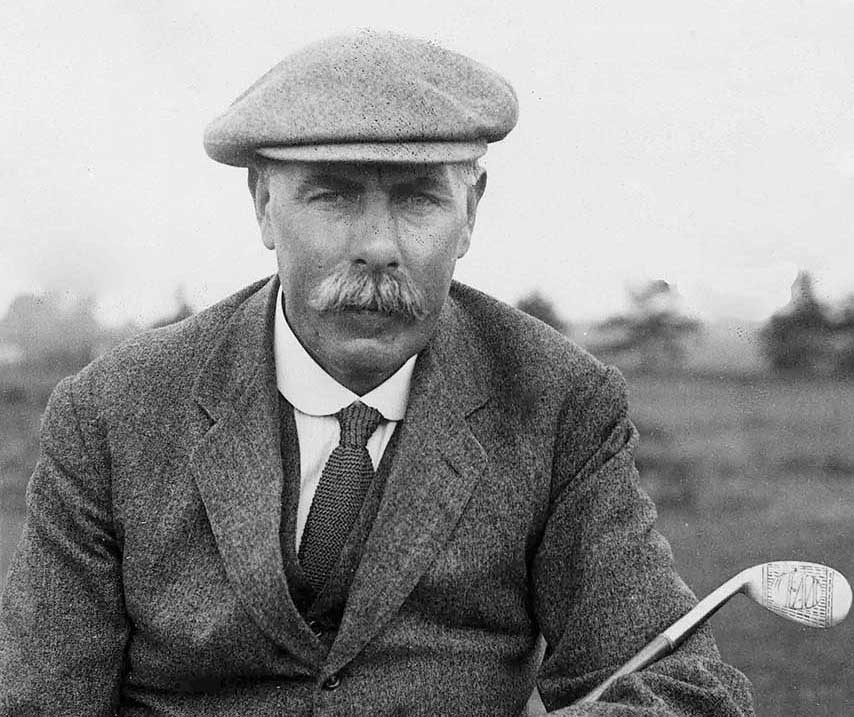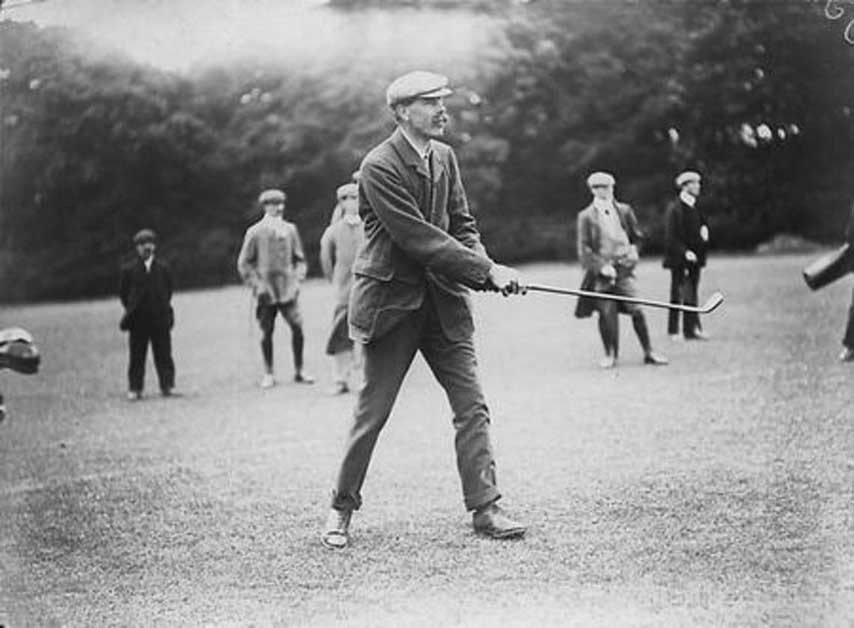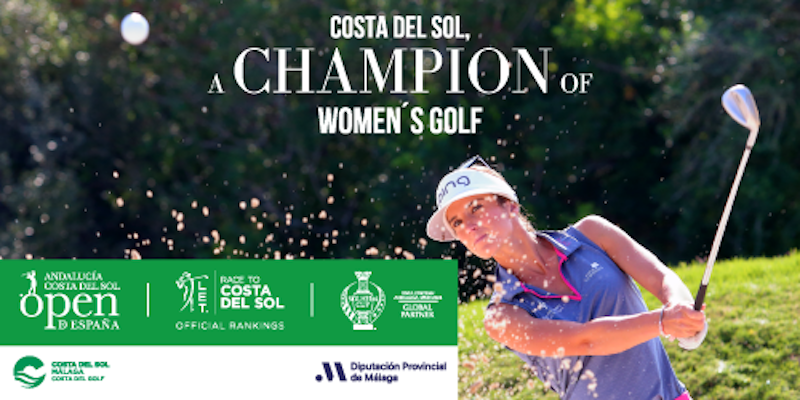
With five wins, Britain’s James Braid and Korea’s Se Ri Pak are eighth in the rankings of major winners.
Braid is regarded as the greatest of Scottish golfers and, along with Harry Vardon and J.H. Taylor, formed what is known as The Great British Triumvirate of golfers at the turn of the last century. Vardon won six British Opens, while the other two members of the triumvirate had five victories each in the famous tournament.
Born on February 6, 1870, the son of a farmer in Earlsferry, Fife, James Braid never had the support of his parents to develop his golfing vocation. Not only did they not support him in his beginnings, but they remained reluctant to their son’s dedication for the rest of his life.

Braid started very early in the sport that would bring him fame and livelihood throughout his life. He won his first local tournament at the age of 8. His interest in the game of golf was complemented by his interest in the manufacture of golf clubs, and in 1893 he made a name for himself in this manufacturing sector in London.
Braid became a professional golfer in 1896, at the age of 26, in Romfford, Essex. He remained there for eight years. His game was characterized by a strong swing, with tremendous drives, but also by very inconsistent green play. While Vardon and Taylor were already winning Opens, Braid never really took off because of his inconsistency with the putter, and he also had his problems with short putts. However, as time went by, he would become one of the most accurate golfers when it came to putting and also one of the most powerful hitters with the driver. Not for nothing did he hold the world record for drive distance, with 395 yards (361 meters), which he achieved on the English course of Walton Heath in 1905. A century later, only a few of today’s golfers, equipped with clubs and balls that were unimaginable at the time, have been able to surpass that incredible distance.
James traded his wooden-headed putter for an aluminum-headed one in 1900. The change suited him well, as the following year he won his first British Open, and went on to win four more through 1910, winning five of those titles ahead of either Vardon or Taylor.

By 1911, Braid had also won the British Professional Match Play four times and the French Open once. He retired from top competition in 1912 to work as a club professional at Walton Heath. He remained at this club until his death.
Braid’s great passion after his retirement from tournament play was golf course design, and it is estimated that he designed or redesigned more than 200 courses in Great Britain. His creative work was limited to his home country because he had an insurmountable fear of flying and shipping, so he had to turn down numerous offers to design courses in the United States. Among the courses he helped remodel were such landmarks as Carnoustie, Troon, Prestwick and Ballybunion.
Many of Braid’s best designs were inland, as opposed to typical coastal links, and several of them introduced the first known dog-leg holes. In fact, several authors do not hesitate to cite Braid as the ‘inventor’ of the dog-leg.
Braid was one of the founders of the British PGA and also had time to write a learning book entitled “Advanced Golf”.
The extraordinary Scottish player died in 1950 in London at the age of 80.
.

THE PIONEER SE RI PAK
Se Ri Pak, will always be remembered as one of the most important pioneers of Asian golf. With her victory in the 1998 U.S. Women’s Open, she inspired the wave of Korean women who have all but taken over the dominant positions on the American Women’s LPGA Tour.
Pak remains the role model. In fact, when she qualified for the World Golf Hall of Fame, at just 29 years old and with a record of 24 LPGA Tour victories, including five majors, she became the youngest person to be elected to that honor (junior Tom Morris, who died at the age of 24, was elected to the Hall of Fame after his death in 1975).
Pak’s most influential victory came in 1998 at Blackwolf Run in Kohler, Wisconsin. When it looked like he no longer had a chance, by sending The ball in the water on the 18th on the last day of the tournament, Pak, knee-deep in water, masterfully pulled the ball out of the water and placed it in the fairway, then holed a 10-meter putt to earn a playoff spot against amateur Jenny Chuasiriporn. The next day, Pak got off to a bad start in the playoff round but made up ground until she managed to tie on the 18th hole. Finally, on what was already the 21st hole of the playoff, she holed a 6-meter birdie putt that gave her the victory and made her, at the age of 20, the youngest U.S. Women’s Open champion.
Pak also won the McDonald’s LPGA Champioinship that year, earning her LPGA Tour Rookie of the Year honors and becoming, along with Juli Inkster, one of only two women to win two majors in their first season as pros on the LPGA Tour.
Pak would go on to win a total of two LPGA Champioinships, and she also won a Women’s British Open in 2001. She also won the 2003 Vare Trophy for the lowest average score of the season, the first Asian player to do so.

In 2007 she won the Jamie Farr Owens Corning Classic for the fifth time, becoming only the third woman in LPGA Tour history to win the same tournament five times. Her playoff record of five wins and no losses is the best in the LPGA in terms of undefeated victories.
Pak also measured herself against the men in the field and competed in a men’s professional tournament, in 2003 at the SBS Super Tournament on the Korean Tour. She finished tenth and thus became the first woman to make the cut in a men’s professional tournament since the legendary Babe Didrickson Zaharias in 1945.
Pak was born on September 28, 1977 in Daejeon, South Korea. Blessed with powerful legs, Pak was a track star before being introduced to the world of golf at the age of 14 by her father, a former professional baseball player in Korea and a demanding parent.
The training regimen she designed for her daughter included racing up skyscraper stairs to the top floor and running barefoot in the snow. As an amateur, the teenage Pak won thirty tournaments. She then turned professional in 1996, winning six of fourteen tournaments on the Korean Tour and finishing second in seven others. In her first six seasons on the LPGA Tour, Pak finished second on the money list four times and was third in another.
Despite all the rigor she endured, Pak has always been known for her broad smile and good nature. However, the pressure of rep
resenting South Korean golf took its toll. In late 1999 she was hospitalized for exhaustion. In 2005 Pak completely lost her game, and her best final ranking was a tie for 27th. Injuries played a role in that decline, but the main cause was the exhaustion of a life she said she “needed a balance.”
Fortunately, she recovered and made a strong comeback, so much so that she won the 2006 McDonald’s LPGA Championship, her fifth major, in a playoff with Karrie Webb.
Pak is a national heroine in Korea, where there are even children’s books featuring her, and she is proud to be the pioneer of dozens of Korean players who have followed in her footsteps on the LPGA Tour.
“I’ve given them the confidence to come here,” he said. “I think of them as my sisters,” he added.















Leave a Reply